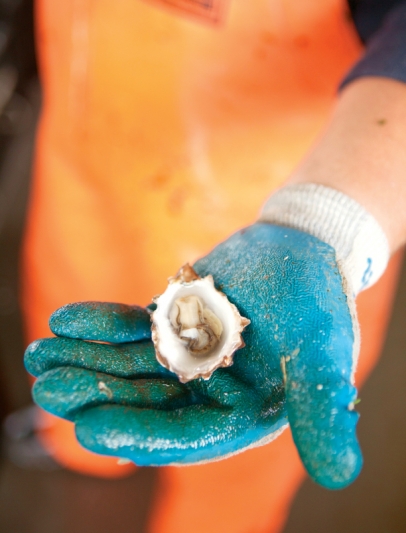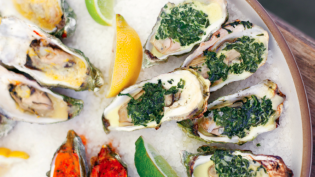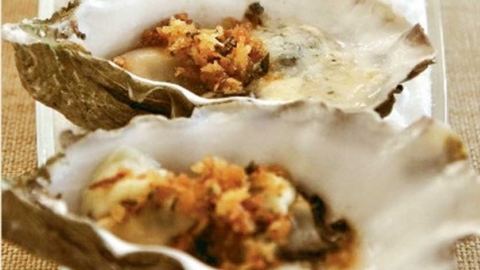Achieving Slurpability: Hog Island Oyster Co.
John Finger, president and co-founder of Hog Island Oyster Co., has a classic California surfer look—his hair is blond and his face is tan; he has crow’s feet spreading from the corners of his eyes, telltale signs of many years spent squinting into the distance to spot the perfect wave. He is not a native son, however, but grew up on the North Fork of Long Island. A place similar to his adopted home of Northern California, a place where you can still fish for your supper and grow your own food.
John wears one pearl earring, a subtle symbol of the turn his life took, from marine biologist to oyster farmer, from oyster hater to oyster guru. It was while studying marine biology at Southampton College on Long Island that he became interested in aquaculture. He interned in La Jolla in Southern California during college, then returned to California after graduation, knocking on doors until he found a position with a shellfish farm in Moss Landing.
Oysters were not love at first bite. John says he never touched one as a youth, despite growing up in the shellfish- rich environment of Long Island. In fact, he says that he didn’t like them initially.
“You have to get used to raw oysters,” he explained. “It’s a texture thing, and your taste buds have to evolve. Also, before California, I had never eaten them right where they were from, on the waterfront.”
After a stint as a mariculture consultant in Europe, John returned to California and, with friend Michael Watchorn, formed Hog Island Oyster Co. in 1983, with a $500 loan from John’s parents and a five-acre intertidal shellfish lease at the northern end of Marin County’s Tomales Bay. According to John, when he first visited Tomales Bay, the mix of agriculture and tourism and the proximity to the big city reminded him of home. He also knew a perfect oyster habitat when he saw it.
“Oysters reflect terroir more than any other food,” he says. “They are what they eat. Literally.”
Tomales Bay is a fog-capped crooked crevice of an estuary. The jagged, boulder-dotted shores are bordered by Pt. Reyes National Seashore to the south and dairy cows grazing on green slopes on the north side of the bay. The pristine loca- tion includes wetlands and river tributaries, nutrient-rich waters, upwelling currents and intertidal activity that create a constant flux of salt and fresh water, making it prime mollusk habitat. In return, the clams, mussels and oysters that thrive here are filter feeders, doing their part to help keep the water- way clean. Shellfish and estuary create a beautiful symbiosis.
At their newly formed company, John and Michael set out to grow an oyster that was perfect for “slurping from the half-shell.” To achieve this, they adopted the “rack and bag” method of oyster farming, originated by a French oyster farmer in Normandy after World War II. Lore has it that the farmer used abandoned military field bed frames as racks, seeding bags with baby oysters and placing them on the bed frame racks in the intertidal zone. This setup is designed to help the baby oysters feed better and protect them from predators. They also develop a deeper shell “cup”—thus enhancing “slurpability.”
But all oysters are not the same. The oyster that is native to this part of the California Coast, the Olympia, was pushed towards extinction due to damage to the bays and overharvesting during the Gold Rush. Even when farmed, Olympias are slow growing and sensitive. Thankfully, three other types of oysters thrive here: Atlantic, Kumamoto and Pacific.
The most common, or popular, strain of the Pacific oyster raised on the West Coast is known as the Miyagi. These oysters often have a deep cup and fruity undertones to their flesh. Hog Island first started growing Miyagis near where Walker Creek meets Tomales Bay, so the fresh water from the creek, also known as “sweetwater,” mingled with the salinity of the bay water, resulting in a nicely balanced oyster—possessing a tangy brine, but also sweet and creamy. These Sweetwater oysters became Hog Island’s signature brand.
While Hog Island was not the first venture to farm oysters in Tomales Bay, they were the first ones to tightly control their product name. The first three restaurants to serve their oysters—Berkeley’s Chez Panisse and San Francisco’s Zuni Café and Hayes Street Grill—all agreed to list them on their menus as “Hog Island Oysters.” A brand was born.
John’s current business partner, Terry Sawyer, joined the company in 1988. After a childhood exploring Florida’s many bays and estuaries, Terry had headed west to California to attend UC Santa Cruz. While pursuing his degree in marine biology and ecosystems, Terry began working at the Monterey Bay Aquarium, specializing in marine animal husbandry. The experience and expertise Terry gained there in creating healthy marine habitats were critically important at Hog Island; keeping a steady supply of shellfish ready to go to market is not a simple or easy task. Sea- sonal rains flood into the bays, bringing with them runoff from neighboring agricultural lands, often halting harvests. To solve this problem, Terry devised an innovative series of wet-storage tanks used for holding oysters that are harvested before the rains, thus ensuring a steady supply.
It is now regular practice at Hog Island to place all their oysters after harvest into wet-storage tanks full of purified bay water before being sending them to market. The oysters naturally cleanse themselves of any grit or undetected bacte- ria while in the tanks, thus providing an extra assurance of the health and quality of Hog Island oysters.
THE FARM AND OYSTER BARS
Today, throngs of oyster lovers head to the small town of Marshall to buy Hog Island oysters by the dozen and crack them open waterside, right at the farm. Reservations for the shuck-your-own picnic tables and barbecue grills book up quickly (so plan well ahead). The farm recently added a more full-service oyster bar, The Boat, open Friday through Monday and offering raw and grilled oysters alongside local cheeses, bread (for soaking up all that delicious oyster juice), beer and wine. They even have their own Marooned on Hog Island Oyster Stout, brewed by 21st Amendment Brewery using bits of the company’s oyster shells, and they recently launched their own Hog Island white wine blend—10% of the proceeds from sales of the wine is being donated to the Tomales Bay Watershed Council. And, of course, you can also buy Hog Island’s oysters, Manila clams and mussels at the farm’s Hog Shack, to take home.
Fulfilling a lifelong dream for John, Hog Island also now operates two oyster-centric restaurants: the Hog Island Oyster Bars located in the San Francisco Ferry Plaza Building and the Oxbow Public Market in downtown Napa. Terry’s wife, an avid and talented gardener, grows some of the produce used in the restaurants in a hillside garden near Tomales Bay and at the COPIA Chefs’ Collective garden in Napa, making this a true family affair.
In serving oysters directly to consumers on the farm, and in farm-owned offsite oyster bars, Hog Island has pioneered a water-to-plate movement in shellfish that has been followed by other shellfish farmers around the country. Excellent examples are Duxbury, Massachusetts’, Island Creek Oysters’ Island Creek Oyster Bar in Boston, Virginia’s Rappahannock River Oysters’ oyster bar in Washington, DC, and Washing- ton State’s Taylor Shellfish Farm’s oyster bar in Seattle.
AN UNCERTAIN FUTURE
Between the success of shellfish sales at Hog Island’s farm and its offsite oyster bars, they can barely keep up with consumer demand. This means they have severely cut back on wholesale sales to restaurants and markets. But even that has not been enough.
Why? Can’t they just step up production? Well, this leads to a larger discussion—and a frightening one, at that. Even if you are not an oyster lover yourself, what is currently happening in the oyster industry should serve as a wakeup call to us all.
Across the board, as consumer demand for oysters has grown, the supply side has declined by 20%. This is due in part to a foe that is much larger and more destructive than any other the industry has dealt with before: ocean acidification. And it is hitting Pacific Coast oysters first, and hardest.
What is ocean acidification? Oceans are known to absorb about 30% of the carbon dioxide in the atmosphere. CO2 is naturally present in the atmosphere as part of the Earth’s carbon cycle, but human activities since the industrial revolution have altered that cycle, and continue to, both adding more CO2 to the atmosphere and obliterating natural carbon “sinks,” such as forests. Scientists are now discovering that carbon is changing the chemistry of seawater, making it more acidic and less “calcium available” to sea creatures that grow shells. These protective coatings are becoming smaller, thinner and weaker.
“Ocean acidification threatens the success of many organisms with shells, such as mussels, clams and oysters,” says Tessa Hill, PhD, of the UC Davis Bodega Bay Marine Laboratory (BBML). “Those animals provide habitat for many other organisms, so there will be a cascade of impacts through estuaries and the ocean. Estuaries are susceptible to both ocean acidification and climate change, which means they may experience changes in temperature, pH and salinity in the future.”
Worse news still is that it’s going to get worse before it gets better, if it gets better. Ocean upwelling, particularly occur- ring in the Pacific Ocean, is bringing up deep sea water that is 30–50 years old, so even if we can drastically reduce our carbon emissions now, it will take a long time to flush through.
One of the first signs of a problem in the oyster industry was the collapse of oyster larvae at the Whiskey Creek hatchery in Oregon. According to Terry, “Initially scientists thought the problem was bacteria. But the crashes had higher frequencies during upwellings. The oysters depend on upwell currents for their food, but these also brought higher pH acid levels, which stressed them and made them more susceptible to disease.” Scientists have determined that oysters are most susceptible in their earliest stages of life because the acidity makes it difficult for them to form shells.
What can be done? At a local level, Hog Island has teamed up with Hill and other scientists at BBML to monitor the levels of acid and temperature changes in Tomales Bay. On a broader level, John and Terry are working to persuade Cali- fornia and federal politicians to make this issue a priority. They are working to create a California Shellfish Initiative, similar to the actions taken by the State of Washington in response to the threat of ocean acidification to that state’s economically important shellfish industry.
In December 2011, National Oceanic and Atmospheric Administration (NOAA) Administrator Jane Lubchenco and then Governor Christine Gregoire of the State of Washington launched the Washington Shellfish Initiative, which included the nation’s first blue-ribbon panel comprised of scientists, tribal leaders, shellfish farmers and federal and state policy makers to study and develop recommendations for the state in response to ocean acidification. Importantly, $3.31 million has been allocated to put the panel’s recommendations into practice. In addition, Governor Gregoire also proposed a new Center for Ocean Acidification at the University of Washington.
In the meantime, shellfish growers are racing to save their oysters and keep their industry from collapsing. One thing they know is that oyster larvae must have a place to grow without assault by high acid levels, and there are currently only two oyster larvae hatcheries on the West Coast, one in Oregon and the other in Washington, both areas susceptible to acidification damage.
Scientific studies are finding that deeper water is more acidic, so if larvae can be grown in shallow, less acidic, water until they form a shell, then they have a better chance of surviving. Washington’s Taylor Shellfish Farms recently launched a hatchery in Hawaii in response to the crisis and Hog Island is starting its own hatchery in Humboldt Bay. When that region’s logging industry faded out, commercial docks on the waterfront were left vacant, creating an ideal space to float rafts full of oyster seed in shallow water. If this hatchery is successful, it will not only help ensure product for Hog Island and its customers, but they will be able to supply other farms with baby oysters.
Should you care about any of this if you are not an oyster lover yourself? According to the National Science Founda- tion’s (NSF) website, “As atmospheric CO2 levels continue to rise, this may serve as the proverbial canary in the coal mine for other ocean acidification impacts on shellfish.” And what if you think you don’t care about shellfish at all? The NSF’s website goes on to state, in part, “Ocean acidification affects marine ecosystems, organisms’ life histories, ocean food webs and biogeochemical cycling. Researchers believe there is a need to understand the chemistry of ocean acidification and its interplay with marine biochemical and physiological processes before Earth’s seas become inhospitable to life as it is known today. Animal species from pteropods—delicate, butterfly-like planktonic drifters [Editor’s note: These are an important source of food for tiny salmon]—to hard corals are affected by ocean acidification. So, too, are the unseen microbes that fuel ocean productivity and influence the chemical functioning of ocean waters.”
And, so, while John and Terry would rather be back home figuring out how to move Hog Island operations to solar power and simply growing more oysters, they both have been spending a lot of time in Sacramento and Washington, DC, these days, trying to encourage lawmakers to respond to this crisis before it’s too late. “It’s a slow and painful process,” Terry said. “But we need to get them to look at the big picture.”
Despite this daunting challenge, both Terry and John say they are strongly optimistic for the future of Hog Island Oyster Co. They both have children who work in the business and they are laying the groundwork for the next generation. Celebrating its first 30 years, Hog Island Oyster Co. is also planting the seeds for the next generation of oyster growers, and eaters.









